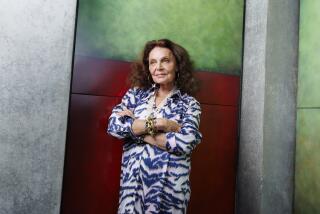Fashions Evolving With Women’s Role
In many ways, the so-called “hobble suit” featured in the Fullerton Museum Center’s current exhibit of women’s fashions resembles the modern-day power suit.
The ensemble features a tunic-style jacket (reproduced for the show in emerald green wool and black trim) and a narrow cigarette skirt.
Introduced during World War I, when women first entered the work force to fill the vacuum left by men caught in the draft, the suit would be entirely at home in a 1980s office except for one telling detail.
The narrow skirt reaches to the floor and has no pleats or slits, symbolically preventing women from taking large steps. Working women would tie their knees together under their dresses in order to look fashionable--hence the name “hobble.”
Fast-forward to the 1980s, and you will see another smartly tailored suit in Reagan red, only this one comes with a short, tulip-style skirt so that women can take big steps, presumably up the career ladder.
Strides made by women during the 20th Century are a common thread that runs throughout the Fullerton museum’s exhibit, “Women in Transition: From Babies to Boardrooms,” on view until Dec. 30.
The museum staff collaborated with the museum’s Textile and Costume Guild, choosing outfits from the guild’s large wardrobe of vintage clothing to reflect the evolution of women’s roles from 1900 to the 1980s.
As the show demonstrates, couture can speak volumes about culture.
Starting with a turn-of-the-century maternity dress, a fuss of ruffles and bows in black silk taffeta, the exhibit follows women’s progress from the home to the business world.
In the early 1900s, most women raised children and managed the household. Their clothing appears as constricted as their career options--long full skirts with tight corsets and high-collared blouses, as illustrated by a bronze silk wedding dress worn in 1909. The delicate gowns with their pleats, trims and tucks contrast sharply with the mass-produced synthetic outfits of the ‘60s--the first time clothing became “a throw-away commodity,” according to Lynn La Bate, exhibition administrator.
Clothes changed dramatically in the ‘20s, after women won the right to vote. The three dresses featured in the show reflect a feeling of liberation and well-being. Hemlines soared to above the knee and waists dropped out of sight so that women were mercifully freed from worrying about their waistlines. They wore their hair in a carefree bob.
War had the greatest influence on women’s fashions, according to La Bate. During World War I, women were needed in the work force, and no hobble suit was going to help the boys overseas. Women wore sensible clothes. Their dresses resembled military-style uniforms. One outfit dating from 1915 to 1920 has a loose black jacket trimmed with braid, buttons and pleats with a full skirt that falls to mid-calf.
“A person can actually walk in it,” La Bate says.
Skirts rose even higher during World War II, in part because of a fabric shortage. Yet suits such as the exhibit’s peach-colored peplum jacket with a matching straight skirt remained conservative, almost masculine, in style.
Only when women turned their attention back to raising families during the baby boom of the ‘50s did clothing again become soft and feminine. Christian Dior had introduced a “new look” of softened shoulders and full skirts in 1947. Women began sporting wide circle skirts with cinch belts and soft sweaters over, as the exhibit duly notes, “a pointy bra.” A flared wool skirt with beige cashmere sweater and matching cardigan capture the period.
Radical changes in society and the roles of women in the ‘60s led to equally radical fashions. Hemlines reached their highest in history. Clothing came in new colors and fabrics. For this period, the show’s display includes a “poison green” coat that barely comes to mid-thigh and striped acrylic hot pants.
As the lines between men’s and women’s roles blurred in the ‘70s, fashions became increasingly unisex, giving rise to the less-than-flattering green-checked polyester pantsuit on display.
As women spread out among the work force in the ‘80s, their outfits become as varied as their roles.
“The main theme is diversity,” La Bate says. “You can see women in styles from the 1900s to now.”
Those who visit the exhibit will find a closet full of memories.
A middle-aged man with two young boys in tow paused before a 1930s brown wool suit with a fur lapel.
“This is exactly what your Grandmother Mackenzie used to wear--before she was rich,” he says. His boys, wearing identical baggy shorts that reach to their knees, appear uninterested.
One can only wonder what the next century will bring.






